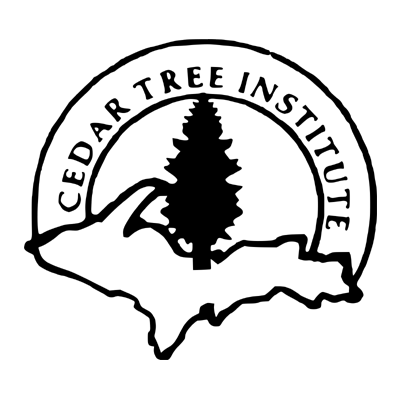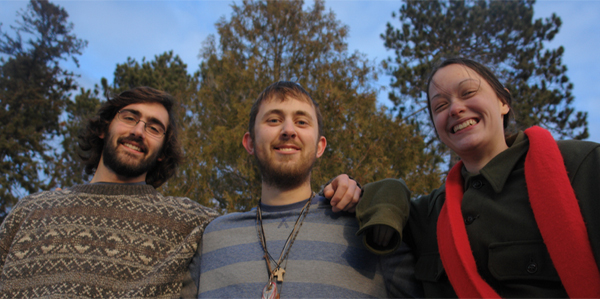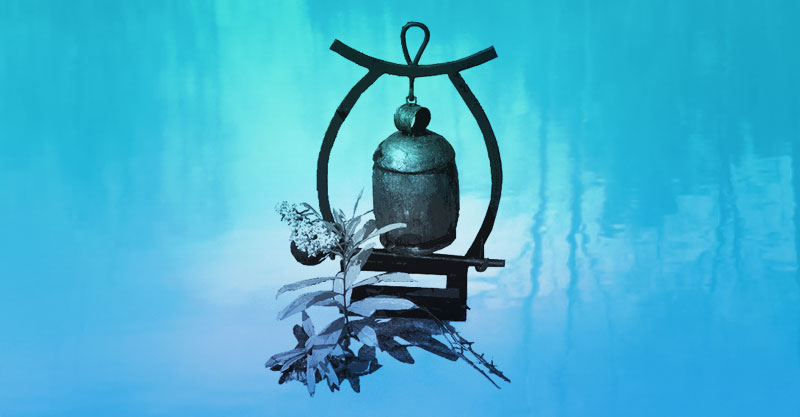Seasonal Notes from the Cedar Tree Institute
Michigan’s Keweenaw Peninsula is a place of rugged, tragic beauty. Forests and rock-cliffed shorelines point north, like some oversized finger, into the vast expanse of Lake Superior. Once a site for thriving copper mines, what’s mostly left now at the end of narrow roads are abandoned buildings and mine tailings: mounds of discarded low grade ore long ago blasted out of underground tunnels.
Over decades, the mining industry’s polluted by-products were dumped into the Lake and drifted south down along the Peninsula’s shoreline. These days, miles of black stamp sands cover what were once pristine beaches. Now, 100 years later, like a scene from a bad movie, two million tons of polluted stamp sands are beginning to leach arsenic and heavy metals into the waters of Keweenaw Bay.
Yet, the Peninsula remains a beloved place for those who live there, and also for adventuresome summer visitors. She is, to be sure, a remarkable, magnificent landscape. Part of Treaty Territory ceded to the United States in 1842 by Native peoples who first inhabited the Great Lakes Basin and who still maintain a Reservation of 14,000 acres, some 30 miles south.
This past summer, a delegation of six tribal youth boarded a 36-foot research vessel operated by Michigan Technological University joining a fish biologist and three staff members from the Cedar Tree Institute. It was the beginning of a three-day learning service project, a trip up the Peninsula’s Eastern shoreline to a campsite at Copper Harbor, then back to the South Entry, which moors what’s left of their tribe’s fledgling fishing fleet.
During our last night together, the vessel’s captain invited our group to look over navigational maps and assist him in planning our return trip. He laid out a compass and several charts, then engaged us in conversation about what it takes to navigate a boat between reefs and buoys, how to estimate nautical miles, and use radar to guide a ship through fog and stormy, starless nights.
Only a fool, it soon became evident, would dare venture onto Superior’s waters without a knowledge of such things. He reminded us that 400 shipwrecks rest on the bottom of Lake Superior. Most caused from failure of human judgment.
The next morning, we spent two hours in fog so dense you couldn’t see more than 20 feet in any direction. But the captain, with one of our group members at his side watching for drift logs, never missed a beat. We arrived at the South Entry within minutes of our scheduled arrival time.
A question haunts me since those days traveling on the water. Why is it we assume we can navigate the ups and downs of our own emotional and spiritual lives without the slightest interest in or knowledge from those who have traveled before us? Without maps for our soul and spirit? Without respect for the often turbulent dangers of the human condition?
Science and a knowledge of history can certainly assist us. But in this instance, I think, sacred myths, religious traditions, and intentional conversations about the meaning of our lives may be more appropriate tools. Traveling on Lake Superior’s waters reminds us that what might appear to be only minor decisions facing us personally may, in fact, have consequences for our political lives, our planet, and our personal journeys beyond anyone’s comprehension.
So what about those shipwrecks? Find a navigator. Pull out some good maps.
– JWM
CONTENTS
- EarthKeepers II: Update
- Spirit of Place
- The Zaagkii Project
- Mind/Body Medicine, Tai Chi & The Iron Butterfly
- Notes of Appreciation
- Religious Life
- On the Horizon
- Ginibiiminaan
- CTI’s Upper Peninsula Index
EARTH KEEPERS II: UPDATE
An Interfaith Environmental Initiative
October brings to a close the work of Earthkeepers II, a second chapter in an unfolding interfaith effort (2004-2014) to protect and sustain the ecology of the Lake Superior Basin.
Here’s the report card: (A) 40 churches (7 faith traditions) completed energy audits with 34 energy conservation projects undertaken, saving those churches and places of worship a total of $20,000 a year in annual expenses. (B) 300,000 lbs. of pollutants are now being reduced annually from those same partner faith-communities. (C) 15 community interfaith gardens have now been established across the Upper Peninsula.
In addition, during 2014, EK II hosted, in cooperation with Northern Michigan University, one of the country’s most respected theologians and ethicists (Larry Rasmussen). He spoke to over 200 students, clergy and community folks. The Earthkeepering team is currently at rest, pondering our resources and energy. (Ref: earthkeepersup.org)
Thanks to Paul Lehmberg (Buddhist), Rayford Ray (Episcopal), and Tom Skrenes (ELCA Lutheran) for providing key support as part of our denominational leadership.
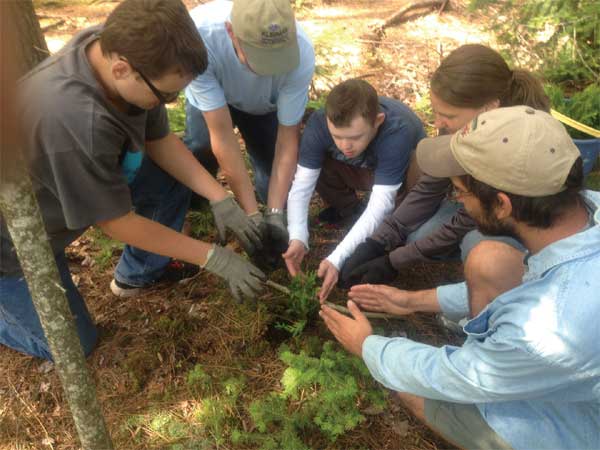
SPIRIT OF PLACE
CTI expresses its appreciation to Lee Goodwin and kayak guide Peter Hutter for helping navigate a journey of both body and spirit along fifty miles of Lake Superior shoreline August 4th-8. Our topic: “The Prophetic Imagination of Flannery O’Connor.” This summer’s participants traveled from Maine, New Hampshire, Wisconsin, New York and Georgia. Winds were quiet, the Lake magnificent.
THE ZAAGKII PROJECT
Thanks to dedicated efforts of Jan Schultz, Chief Botanist for the Eastern Region of the US Forest Service, a unique, one-of-a kind partnership has arisen to support the work of five regional American Indian tribes here in Northern Michigan. The collaborative work seeks to recover and protect what is left of the native plant life remaining here in the Upper Peninsula. Five tribal councils have passed resolutions to support this project connecting ancestral knowledge with the best of science research. (Ref: wingsandseeds.org)
MIND/BODY MEDICINE, TAI CHI & THE IRON BUTTERFLY
Thanks to CTI friends and supporters Lisa Long, MD, and Lee Ossenheimer for leading one of a series of Institute’s “Iron Butterfly” workshops on 6/14 at Marquette’s Presque Isle Pavilion. These workshops focus on health, well-being, and recovering connections between the body, mind, and spirit. Tai Chi Chuan classes continue each Wednesday at Grace United Methodist Church (5:30 – 6:30 P.M.) with regularly scheduled monthly workshops. Presentations on mind/body practices also took place at Echo Lake Nature Preserve on 7/12 and KBIC’s Ojibwa Community College 6/5.
NOTES OF APPRECIATION
In an effort to heal and restore our forests, this past summer the Cedar Tree Institute worked with youth volunteers from Faith Lutheran Church in Marion, Iowa led by Danny Stone and Messiah Lutheran Church planting 300 Northern white cedar trees along Harlow Creek and the Yellow Dog Watershed.
And a bow of appreciation to Mike Grossman, MD, and Larry Skendzel, MD, Marquette Country hospice medical directors! They helped design and coordinate this fall’s CTI Janus Project held 9/19-21 at Beaufort Lake. This was our 13th in a series of small group training projects for hospice workers. We were honored to have Ray Williams, Swinomish tribal elder (LaConner, Washington) and architect Art Peterson travel from Seattle to serve as special guests and presenters.
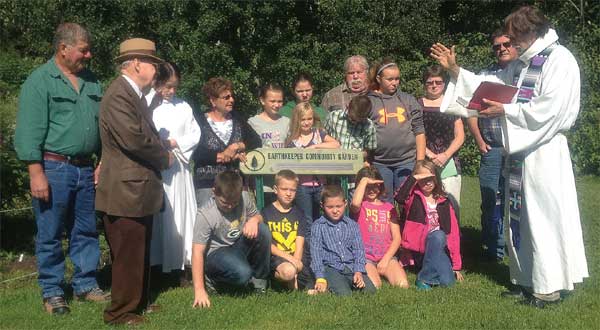
RELIGIOUS LIFE
CTI’S Director provided liturgical leadership and served as guest preacher at Eden Lutheran Church in Munising on 8/17, 8/30, and 9/6, and also as guest presenter for Marquette’s Unity Church on 6/8.
He served as a guest homilist for the funeral of Patti Durocher on 6/7 at St. Christopher’s Roman Catholic Church in Marquette. Patti and her husband Steve have been supporters and friends of the CTI’s work since 2008. He also presided for a house blessing at NMU student Katelin Bingner’s dorm room. Katelin also preached her first sermon on 9/7, as a prospective seminary student, at Eden Lutheran Church.
The Director continues his role as clergy representative on the Lake Superior Binational Forum (A U.S. and Canadian oversight group mandated to help protect the quality of life and natural resources in the Lake Superior Basin).
ON THE HORIZON
Upper Great Lakes Palliative Care Conference 10/21-22
Northern Michigan University
CTI’s Director will present a workshop on “Passages: Spiritual Perspectives on Illness and the End of Life.”
A Language of the Heart
Empathy Training for Medical Students and Clergy
With co-facilitator Ray Hasenauer, MSW
November – December, 2014 (TBA)
GINIBIIMINAAN
Ojibway for “Our Living Waters”
On 8/18-20, six youth from the Keweenaw Bay Indian Community (KBIC) joined MTU’s Dr. Nancy Auer, a fish biologist, and three staff from the Cedar Tree Institute for a service-learning project along 50 miles of the rugged Keweenaw Peninsula. They traveled on the 36-foot Agassiz with supervisor Tonya Swenor and Captain Stephen Roblee, learning to test water temperature, exploring the Lake Superior’s food web, and utilizing a seiner net.
This venture followed last year’s 5-day trip (Maamaadizi, “Beginning the Journey”). 10 KBIC tribal youth and a Sault Ste. Marie Tribe of Chippewa Indians representative were involved: Isle Royale National Park our destination. Thanks to Tom and Nancy Auer for making the Agassiz, MTU’s premier research vessel, available for both events.
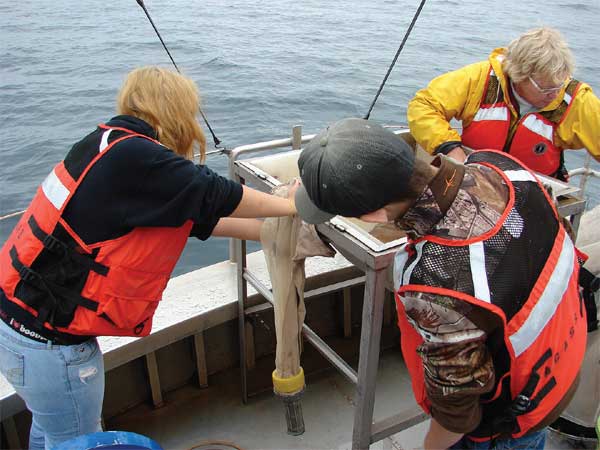
CTI’S UPPER PENINSULA INDEX
- Percentage of boundary land of Michigan’s Upper Peninsula that is Great Lakes shoreline: 88
- U.P. related words added to Merriam-Webster’s dictionary this year (“yooper” & “catfish”): 2
- Years it took a Gladstone man to convince Merriam-Webster Dictionary to add “yooper”: 12
- Percentage of foreign-born residents in Marquette County -in 1900 & 2010: 43, 1.4
- Average percentage today, in the U.P.’s 15 counties: 1.9
- Votes it took the Gwinn Chorale to win a singing date with the band Foreigner: 157,055
- Number of potato and rutabaga warehouses built in the U.P. with federal aid in 1934: 24
- Percent increase in drug-addicted newborns at Marquette General Hospital, 2008-2013: 378
- Number of years Carl Levin has represented the U.P. in the U.S. Senate: 36
- Acres of Michigan land designated federal wilderness during his tenure: 133,826
Researched by Gabriel Caplett, organic farmer, writer and community organizer.
Our mission is to contribute quietly to the Common Good. The Cedar Tree Institute owns no property and has no full time employees. We choose not to compete with United Way agencies or local faith communities for limited financial resources. We carry on this work, thanks to small grants and donations by residents in Michigan’s Upper Peninsula and to individuals, some as distant as New Mexico, Hawaii, Washington State, and New York.
To you our deepest appreciation!
The Fall 2014 Equinox Newsletter is brought to you by Cedar Tree Institute.
